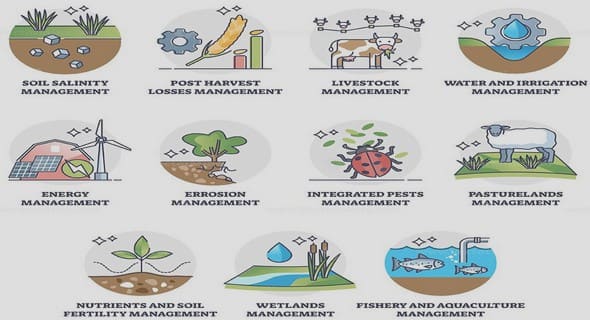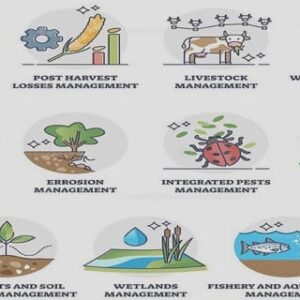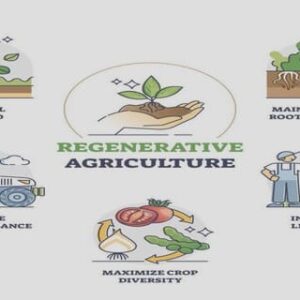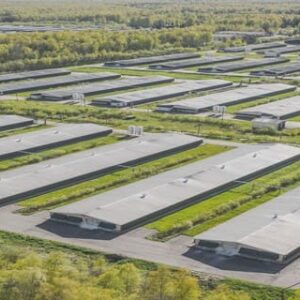(Downloads - 0)
For more info about our services contact : help@bestpfe.com
Table of contents
Introduction – Synthesis Chapter
1.1. General introduction
1.1.1. Today’s and tomorrow’s challenges for the agriculture
1.1.2. Designing farming systems
1.1.3. Agricultural production systems and complex systems
1.1.4. Global challenges in designing agricultural production systems
1.2. Thesis project
1.2.1. Research context
1.2.2. Thesis objectives
1.3. Thesis proceedings
1.4. Thesis results
1.4.1. Literature review on adaptation in decision models
1.4.2. The Berambadi watershed
1.4.3. A methodology to guide the design of a conceptual model of farmers’ decision-making processes
1.4.4. The conceptual model NAMASTE
1.4.5. Strategic decisions on investments and cropping systems modeled with a stochastic dynamic programming approach
1.4.6. The computer model NAMASTE
1.5. Discussions and prospects
1.5.1. Review on the thesis results
1.5.2. From the demonstration prototype to the production model
1.5.3. Verification and validation
1.5.4. A decision model for the AICHA project
1.6. Conclusion
Processes of adaptation in farm decision-making models- A review
2.1. Introduction
2.2. Background on modeling decisions in agricultural economics and agronomy
2.3. Method
2.4. Formalisms to manage adaptive decision-making processes
2.4.1. Formalisms in proactive adaptation processes
2.4.2. Formalisms in reactive adaptation processes
2.5. Modeling adaptive decision-making processes in farming systems
2.5.1. Adaptations and strategic decisions for the entire farm
2.5.2. Adaptation and tactic decisions
2.5.3. Sequential adaptation of strategic and tactical decisions
2.6. Discussion
2.6.1. Adaptation: reactive or proactive process?
2.6.2. Decision-making processes: multiple stages and sequential decisions
2.6.3. What about social sciences?
2.6.4. Uncertainty and dynamic properties
2.7. Conclusion
Farm typology in the Berambadi watershed (India): farming systems are determined by farm size and access to groundwater
3.1. Introduction
3.2. Materials and methods
3.2.1. Case study: Hydrological and morphological description of the watershed
3.2.2. Survey design and sampling
3.2.3. Analysis method
3.3. Variability and spatialization of farm characteristics and practices
3.3.1. Farm structure
3.3.2. Farm practices
3.3.3. Water management for irrigation
3.3.4. Economic performances of the farm
3.4. Typology of farms in the Berambadi watershed
3.4.1. Characteristics of farm typology
3.4.2. Characteristics of the farm types
3.5. Discussion
3.6. Conclusion
Acknowledgements
Table caption
Figure caption
CMFDM: A methodology to guide the design of a conceptual model of farmers’ decision-making processes
4.1. Introduction
4.2. Founding principles of the methodology
4.3. The CMFDM methodology
4.3.1. Step 1: problem definition
4.3.2. Step 2: case study selection
4.3.3. Step 3: data collection and analysis of individual case studies
4.3.4. Step 4: the generic conceptual model
4.4. Methodology implementation in a case study
4.4.1. Step 1: problem definition
4.4.2. Step 2: case study selection
4.4.3. Step 3: data collection and analysis of individual case studies
4.4.4. Step 4: the generic conceptual model
4.5. Discussion – Conclusion
Acknowledgements
Figure caption
Adaptive and dynamic decision-making processes: A conceptual model of production systems on Indian farms
5.1. Introduction
5.2. Modeling processes
5.2.1. Indian case study
5.2.2. Modeling steps
5.2.3. Conceptual validation
5.3. A conceptual model of production systems on Indian farms
5.3.1. What should be modeled
5.3.2. Modeling in NAMASTE
5.3.3. Description of the other systems in the model
5.4. Discussion
5.5. Conclusion
Acknowledgements
Table caption
Figure caption
A stochastic dynamic programming approach to analyze adaptation to climate change – application to groundwater irrigation in India
6.1. Introduction
6.2. Literature review on long-term farmer decisions under uncertainty
6.3. Methods
6.3.1. The farmer’s production problem
6.3.2. Data
6.4. Simulations and results
6.4.1. Scenarios
6.4.2. Results
6.5. Discussion
6.6. Conclusion
Acknowledgements
Table caption
Figure caption
NAMASTE: a dynamic model for water management at the farm level integrating strategic, tactical and operational decisions
7.1. Introduction
7.2. Materials and methods
7.2.1. Conceptual modelling
7.2.2. RECORD: a modeling and simulation computer platform
7.3. Description of the farming system model
7.3.1. Models used to build the farming system model
7.3.2. Model structure
7.3.3. Dynamic functioning
7.4. Application case: the NAMASTE simulation model
7.4.1. Coupling the farming system model to the hydrological model
7.4.2. NAMASTE simulaton
7.4.3. Calibration and validation
7.4.4. Simulation results
7.5. Discussion
7.6. Conclusion
Acknowledgements
Figure caption
Bibliography
Appendix
Appendix 1: Thesis sequence of events
Appendix 2: Data used in NAMASTE development
Appendix 3: Conceptual model and Ontology
Appendix 4: Economic model – Model equations
Appendix 5: Economic model – Yield estimations and climatic expectations
Appendix 6: Operational decision and modeling
Appendix 7: Coupled model – a village with two farms



